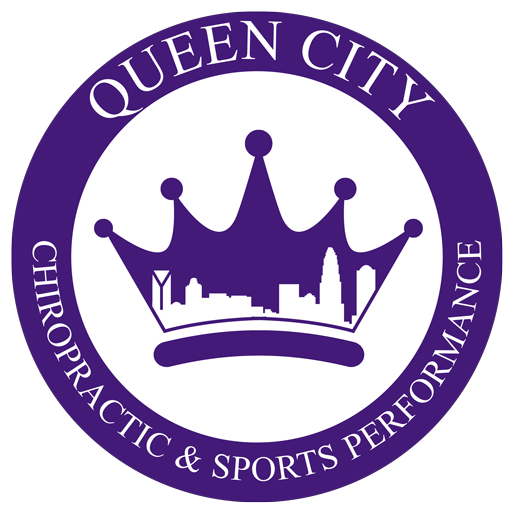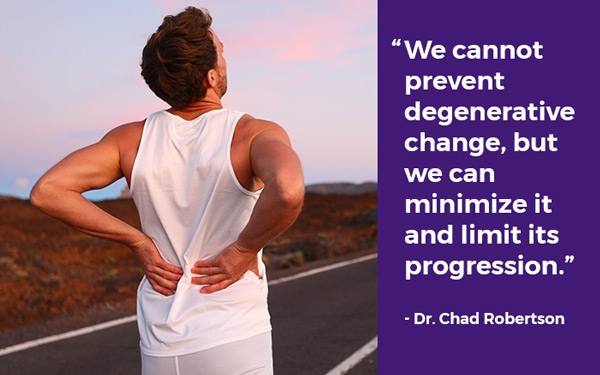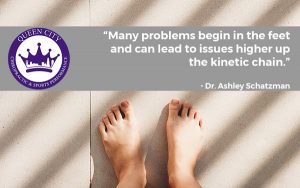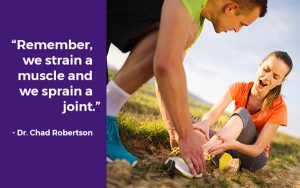Perhaps it’s the sign that you read in the lobby of Queen City Chiropractic & Sports Performance that announces this office offers Spinal Decompression Therapy that sparks your curiosity. We encourage our clients to ask or wonder, would spinal decompression be an appropriate treatment?
The answer is usually a simple one…
ABSOLUTELY! It helps most everyone, but some benefit more than others.
What Is Spinal Decompression Therapy?
According to the American Chiropractic Association, Spinal Decompression Therapy is defined as an alternative, noninvasive, nonsurgical procedure of applying axial (head to toe) traction to the vertebral bodies and spinal column.
This form of conservative treatment can be utilized for a wide variety of conditions including mechanical lower back pain, pain associated with cervical, thoracic or lumbar disc injuries, degenerative disc disease, spinal facet syndrome, spinal stenosis and certain radiculopathies such as sciatica or numbness and tingling.
The objective for this treatment is to relieve the pressure gravity places upon the spine while alleviating the irritation that is generated by the inflamed nerve(s).
The Negative Effects of Gravity and Technology
Gravity accomplishes a lot of beneficial things, however one negative aspect of gravity is the stress it places upon on our joints.
The spine is comprised of 24 moving bones called vertebra, each separated by an intervertebral disc. The spine is aligned so that the bones form a tube-like column that features a series of natural front to back curvatures. These curves are present to help evenly distribute a person’s body mass against gravity.
If the spine was perfectly upright, like the trunk of a tree, it would be stressed at a far higher rate over time and be weaker. When properly positioned, the spine is flexible yet resilient. However the prevalence of unnatural movement patterns along with our dependence on technology has predisposed certain areas of our spine to stress and become susceptible to injury.
Some portions of our spine are more vulnerable to injury due to deconditioning (aka: being out of shape), our failure to learn to “listen” to our body along with the natural limitations that comes with aging.
Our dependency upon technology also causes our spine to “age” faster than previous generations because our daily activities tend to promote more sedentary behaviors which allows the spine and the spinal soft tissue to weaken faster.
Our spine is both the frame and suspension
If we compare the human body to a pick up truck, the spine would serve as both the frame that provides strength and support as well as the suspension system that acts to absorb and disperse the forces applied upon it.
So, with gravity constantly applied to the spine, magnified when objects are held or lifted, the spine acts like an over-loaded truck being compressed down upon its tires without ever being unloaded.
Would it not seem plausible that this truck’s frame and suspension wouldn’t last as long as a similar truck that never carried a heavy load?
When excessive pressure is applied to the spine over time or unexpected forces are applied, as with an injury, the discs and joints of the spine will only absorb so much tension before it can no longer prevent nerves from becoming irritated.
The intervertebral discs act like shock absorbers located between the vertebra. These discs keeps the bones from compressing too much upon one another and also provide adequate space for the spinal nerves to exit the spinal cord.
Discs and jelly doughnuts?
The disc acts similar to a jelly doughnut in that it has a soft, compressional center called the nucleus that is surrounded by a firm (fibrous) exterior ring called the annulus fibrosis. If the pressure is too great, the center nucleus migrates through the outer protective boundaries of the annulus and can irritate the adjacent nerve in the form or a disc bulge or herniation.

This is like squeezing a doughnut and the jelly center bulges to one side.
Discs are flexible and well-hydrated in our youth but over time, the water content of the disc diminishes while the strength of the disc becomes limited.
Too often we have a great ability to ignore the symptoms of this pressurizing of the spine that occurs naturally over time and overlook the symptoms as simple “tension or tightness”.
We might admit we need to stretch more often or drink more water which are both good ideas, but if we don’t take an active approach soon enough, problems begin to develop.
If a subtle loss of motion occurs between two segments (joints), we run the risk of losing that capability permanently if action steps aren’t taken. When a joint loses its natural motion capability we refer to that process as degeneration. Degeneration is a normal process and an example of decay.
We cannot prevent degenerative change, but we can minimize it and limit its progression through exercise and movement. Once a disc or surrounding joint shows the signs of degeneration, medical doctors often diagnose Degenerative Disc Disease.
This may be an intimidating diagnosis but it is common and can be treated conservatively when approached in an appropriate fashion.
How Does Spinal Decompression Therapy Help?
The discs are attached to a boney vertebral segment on the top and bottom by tiny ligaments. This bone to disc relationship is similar to a ceiling and a floor separated by office space in a sky-scraper building.
When the ceiling is pushed toward the floor, the walls (disc) expand outward in the direction of least resistance. Over time, repetitive stress causes a disc weakness called a bulge.
If a disc bulge is ignored too long or if a sudden excessive force is applied, the disc can rupture. This is termed a herniation (or protrusion or extrusion).
Bulges are quite common with people over the age of 40 due to the stress introduced to the spine over time. Disc bulges are manageable and can be treated conservatively in most instances.
Disc herniations are often obvious and result in pain of both the spine and extremities. This injury is more serious and while it can respond to conservative care, often surgery is recommended.
Discs do heal over time under most circumstances, however due to the stress gravity and our daily tasks create, healing is a slow process. Spinal Decompression creates a force that is opposite to gravity in an effort to accelerate the healing process.
Tools of the Trade
A Spinal Decompression table allows you to lie supine (face up) removing gravity’s influence on your body.
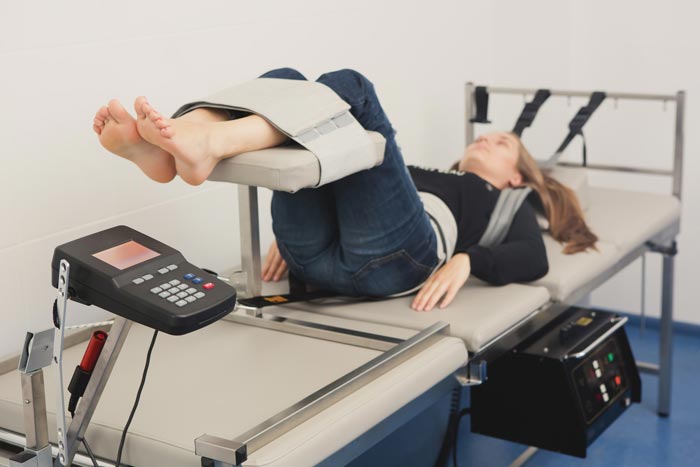
The table is designed to address and treat both neck and the lower back ailments depending on your condition. You are secured to the table using a series of padded straps while a slight traction force is exerted upon your body.
Essentially, we stretch the ceiling away from the floor allowing the walls (disc) to expand back into the natural position. This stretching is barely noticeable to you during treatment.
Spinal Decompression exerts a negative pressure upon the disc and helps migrate the nucleus back into a more centralized position. This is where the term “decompression” stems from. We are removing the compression gravity places upon your spine.
Personalized Treatment Plans
After a comprehensive physical examination, we are able to develop a unique decompression treatment plan specific to your needs. There are no one-size-fits-all or cookie-cutter treatments with Spinal Decompression. Each treatment plan is unique.
Typical traction treatments require a slight introduction period to determine optimal results, but will eventually average around 20-30 minutes from start to finish. Treatment plans also include customary chiropractic protocols to improve spinal alignment and mobility prior to traction along with modalities to diminish pain and soreness for optimal results.
Complimentary exercises and stretches are also recommended for you to be utilized both in the office and at home for best results.
Disc conditions are not the only conditions that can be improved with Spinal Decompression Therapy. Excessively tight muscles can be relaxed as well as stiff joints mobilized with the effects of traction.
There are some circumstances and situations that may exclude you from being an appropriate candidates for Spinal Decompression.
Some common reasons include the presence of pathology (such as cancer or infection), poor bone density (osteoporosis), some respiratory ailments where breathing is difficult in a supine position, spinal fractures or spinal stress fractures along with some forms of previous spinal surgery.
Come see if Spinal Decompression Therapy is right for you
A consultation at Queen City Chiropractic & Sports Performance is always free and you can speak with one of our great doctors to determine if Spinal Decompression is an appropriate treatment for you!
Doctors have understood the importance of traction therapy for decades to alleviate spinal pain. With contemporary research, we now have a better understanding of the importance of the delicate balance between ideal and insufficient movement of the spinal segments along with how adequate mobility delays normal degenerative changes.
With technology and the latest equipment, we can now isolate where traction is applied to the spine so the benefit is where it is needed most to reduce the problem. This allows us to create an ideal healing environment within the body that is intended to address the exact cause of your problem. This also allows us to treat a variety of people, all with different conditions, with the same equipment.
Rehabilitation means “return to normal” yet we all know healing requires time. Think of the amount of time the body has been in a stressed, compressed state before problems were noticed?
Any effective treatment will require time, repetition and patience.
At Queen City Chiropractic & Sports Performance we look forward to helping each patient who walks through our door. We strive to help everyone achieve an ideal internal environment for accelerated healing to occur. Spinal Decompression might just provide the missing piece to you achieving optimal health and wellness. Stop by our facility and see for yourself!

